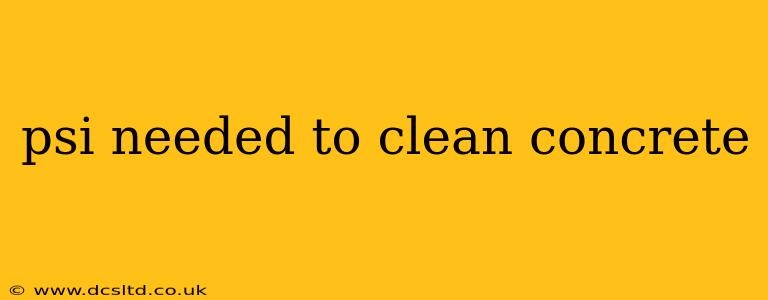PSI Needed to Clean Concrete: A Comprehensive Guide
Cleaning concrete effectively requires understanding the right amount of pressure. Using too little pressure won't remove dirt and grime, while too much can damage the surface. This guide will explore the PSI (pounds per square inch) needed for various concrete cleaning tasks, along with factors influencing pressure selection and safety precautions.
What PSI is Right for Cleaning Concrete?
There's no single PSI that works for all concrete cleaning jobs. The ideal pressure depends heavily on the type of concrete, the level of soiling, and the cleaning method employed. Generally, you'll find that different cleaning tasks fall into these PSI ranges:
-
Light Cleaning (Removing loose dirt, dust, and light stains): 1500-2000 PSI. This is suitable for routine maintenance and removing surface-level grime. Lower-pressure options may suffice, particularly with a good detergent.
-
Medium Cleaning (Removing stubborn stains, mildew, and algae): 2500-3000 PSI. This range is effective against more persistent dirt and requires a more powerful pressure washer.
-
Heavy-Duty Cleaning (Removing heavy grime, paint, oil, and graffiti): 3000-4000 PSI. For extremely dirty or damaged concrete, a high-pressure washer is necessary. However, exercise extreme caution at these higher pressures to prevent damage.
Factors Influencing PSI Selection
Several factors influence the appropriate PSI for your concrete cleaning project:
-
Type of Concrete: Porous concrete requires lower pressure to avoid damage, whereas denser concrete can withstand higher pressure.
-
Surface Condition: Cracked, chipped, or otherwise damaged concrete needs lower pressure to prevent further deterioration.
-
Type of Dirt/Stain: Different stains require different cleaning approaches and pressure levels. For example, oil stains may require a degreaser and lower pressure to avoid spreading.
-
Cleaning Method: Using a surface cleaner attachment reduces the risk of damage compared to using a direct pressure nozzle.
-
Nozzle Type: Different nozzles produce varying spray patterns and pressure intensities. A wider fan nozzle spreads pressure more evenly, reducing the risk of damage.
What PSI is too high for cleaning concrete?
Using excessive PSI can damage concrete, leading to pitting, etching, or even structural damage. The maximum safe PSI varies depending on the factors mentioned above, but exceeding 4000 PSI is generally considered risky for most concrete surfaces. Always start with lower pressure and gradually increase it as needed.
What is the best PSI for a pressure washer to clean concrete?
The "best" PSI is relative to your specific task. A pressure washer with adjustable PSI settings is ideal. This allows you to tailor the pressure to the job at hand, ensuring effective cleaning without damaging the concrete.
Can I use a pressure washer with lower PSI to clean concrete?
Yes, lower PSI pressure washers (under 1500 PSI) are suitable for light cleaning tasks. However, for tougher stains and grime, you'll likely need a higher PSI setting.
What nozzle tip should I use to clean concrete with a pressure washer?
For concrete cleaning, a 15° to 40° nozzle tip is generally recommended. The wider fan pattern of these nozzles spreads the pressure over a larger area, making cleaning more even and minimizing the risk of damage.
Safety Precautions
Always prioritize safety when using a pressure washer:
-
Wear safety glasses and protective clothing. High-pressure water can cause serious eye injuries.
-
Maintain a safe distance from the concrete surface. Avoid pointing the nozzle directly at yourself or others.
-
Test the pressure in an inconspicuous area first. This helps ensure the pressure level won't damage the concrete.
-
Never point the nozzle at yourself or others.
By carefully considering these factors and taking necessary safety precautions, you can effectively clean your concrete surfaces while minimizing the risk of damage. Remember, starting with a lower PSI and gradually increasing it is the safest approach.
